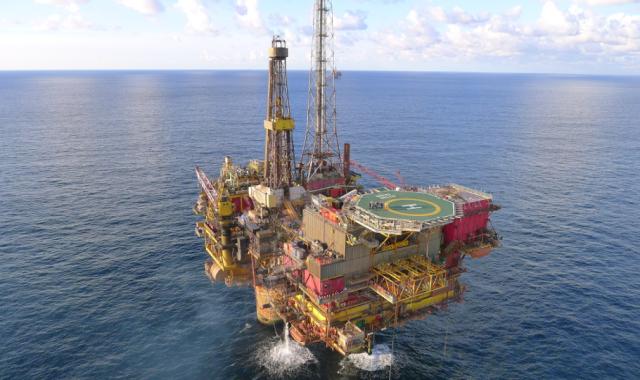
The Brent Delta ended production in 2011. Work is already underway on the topside lift for Brent Delta. (Source: Shell)
Production from the Brent Field began in 1976 and since then has reached about 3 billion barrels of oil equivalent—almost 10% of total U.K. production. Shell, the operator, recently submitted a decommissioning plan to the U.K. Department of Business, Energy and Industrial Strategy (BEIS) to begin removing the Brent Alpha, Brent Bravo, Brent Charlie and Brent Delta platforms in 460 ft (140 m) of water in the North Sea.
Three of the platforms are concrete gravity-based structures (GBS) and the fourth platform is steel. The Brent Bravo and Brent Delta are GBS built by Norwegian Contractors. The Condeep platforms were installed in 1975 and 1976. The Brent Charlie is a GBS built by McAlpine/SeaTank and installed in 1978. Each of the concrete structures weighs about 300,000 metric tons without the topsides.
The Brent Delta ended production in 2011, and the Brent Alpha and Brent Bravo stopped producing in November 2014. The Brent Charlie is expected to continue producing for several more years.
Those huge storage cells at the bottom of the GBS required a different solution than conventional steel platforms. Shell, which is a 50% shareholder in the Brent Field with ExxonMobil Corp. subsidiary Esso Exploration and Production UK Ltd. (50%), recommended that the three GBS, the sediment contained and the attic oil within their concrete storage cells, and drill cutting piles remain in place. The plan also called for removing the upper steel jacket of the Brent Alpha platform and leaving the rest in place.
Work is already underway on the topside lift for Brent Delta, which is expected to be removed in a single lift in summer 2017.
Three options for decommissioning the GBS were identified: complete removal by refloating; partial removal by removing some or all of each leg; or leave in place.
The risks of failure for complete removal are about 1,000x higher than would be considered acceptable by the E&P industry at the start of any new project. Therefore, the refloat option was ruled out.
After a comparative analysis of the remaining two options, leave in place was selected. The conductors and casings in the drilling legs and the pipework and steel infrastructure in the utility leg of the two Condeep platforms would be left in place.
On the SeaTank platform (Charlie), the external conductors and conductor guide frames located between legs C3 and C4 would be cut and taken to shore for dismantling and recycling. Conductors on the platform would be undertaken as part of topsides removal or other subsea removals.
The position and new status of each GBS will be formally notified to other users of the sea through the U.K. Hydrographic Office and marked on charts. Aids to navigation will be fitted to the concrete cap on one leg of each GBS. The three platforms also will be incorporated in the FishSAFE system to provide early warning to commercial fishing vessels.
Assessments for the life of the platforms predicted the GBS will deteriorate and collapse over a period of about 1,000 years.
When Brent Charlie is finally decommissioned, that will end the production of the benchmark Brent crude, which is a mix of production from 15 North Sea fields. So perhaps the market will continue to use “Brent” as the marker name even though there will be no Brent production.
Recommended Reading
Baker Hughes: US Drillers Cut Oil, Gas Rigs for First Time in Four Weeks
2024-11-15 - U.S. energy firms this week cut the number of oil and natural gas rigs operating for the first time in four weeks.
A Tale of Two Strategies: How Baker Hughes, NOV are Traversing the Natural Gas Age
2024-11-06 - Natural gas demand is on the rise, and with that comes a flurry of measures to capitalize on evolving market needs. How are Baker Hughes and NOV navigating the changing energy landscape?
Dallas Fed: Trump Can Cut Red Tape, but Raising Prices Trickier
2025-01-02 - U.S. oil and gas executives expect fewer regulatory headaches under Trump but some see oil prices sliding, according to the fourth-quarter Dallas Fed Energy Survey.
Pickering on Permian: Marginal Barrels, Stripper Wells, More
2024-12-02 - As the Permian Basin matures and global oil demand grows, Dan Pickering, chief investment officer for Pickering Energy Partners, offers his thoughts on the basin’s future, costs, demand and the price of oil.
Predictions 2025: Downward Trend for Oil and Gas, Lots of Electricity
2025-01-07 - Prognostications abound for 2025, but no surprise: ample supplies are expected to keep fuel prices down and data centers will gobble up power.
Comments
Add new comment
This conversation is moderated according to Hart Energy community rules. Please read the rules before joining the discussion. If you’re experiencing any technical problems, please contact our customer care team.




